Day 4 of a four day Autumn Migration tour, our last day. It was a damp and misty morning with drizzle on and off, but we managed to make the best of it, and it dried out in the afternoon, even if it remained rather breezy.
We started the day at Holkham. It was grey and drizzling as we got out of the minibus on Lady Anne’s Drive, to the sound of small parties of Pink-footed Geese flying over in the mist.
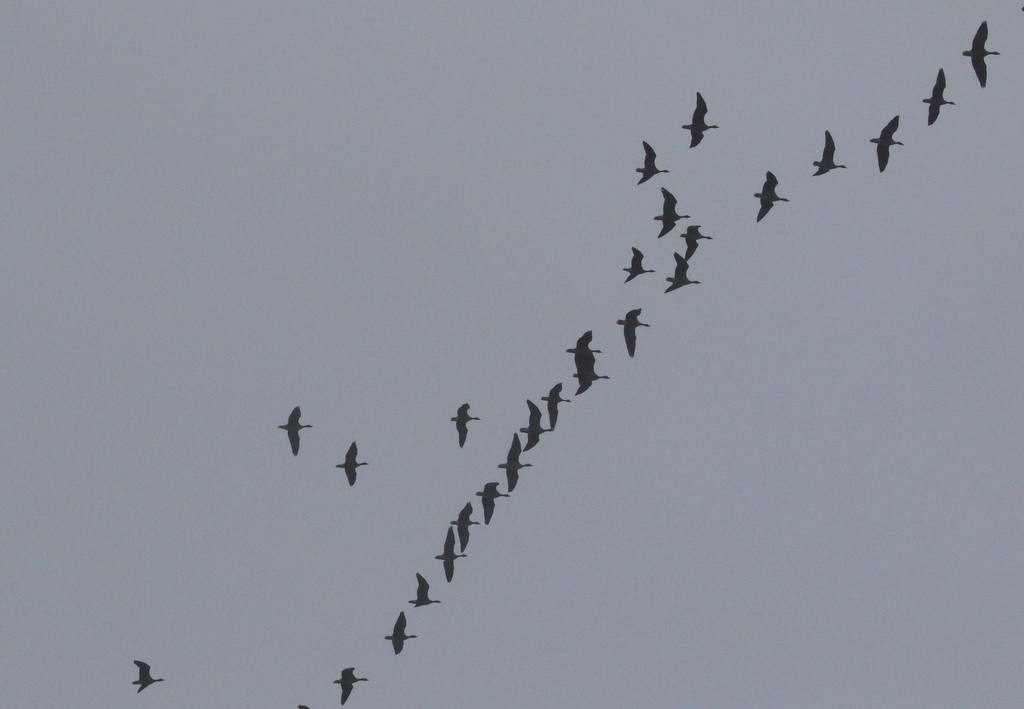
A Common Gull was feeding on the short grass opposite and conveniently walked over to a Black-headed Gull for a nice side-by-side comparison. Further back, we spotted a covey of Grey Partridges. They were hard to see in the dull conditions, in amongst the lumps of mud where the channels on the grazing marsh have just been excavated, so we walked over to The Lookout cafe where we could get a bit of elevation and get a better look at them. Several Jays came out of the trees, and headed off up Lady Anne’s Drive.
Walking west on the track on the inland side of the pines, we could hear tits in the trees and then a Yellow-browed Warbler called further up. We walked on to see if we could locate it, but by the time we got to where it had been it had gone quiet again and there was no movement in the trees by the track.
We stopped briefly at Salts Hole. A lone Tufted Duck flew off with the Mallards as we walked up. There are several Little Grebes on here now, where they spend the winter, and they seemed to be laughing at us, out in the drizzle.
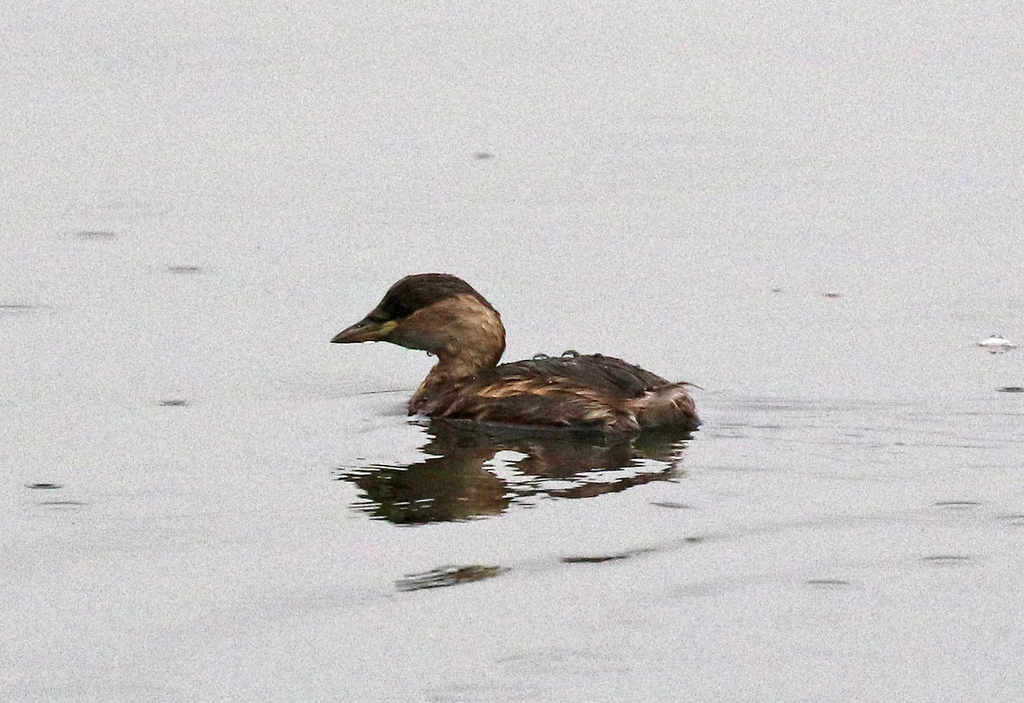
We stopped again to scan the grazing marshes just before Washington Hide, but got distracted by a tit flock calling from the trees the other side. One of the group went over to look at the grazing marsh, and a Great White Egret and a Grey Heron feeding over the grass on the edge of a shallow reedy channel. It was a good size comparison – the Great White Egret at least the size of the heron. A second Great White Egret was more hidden, in a ditch a little further back.
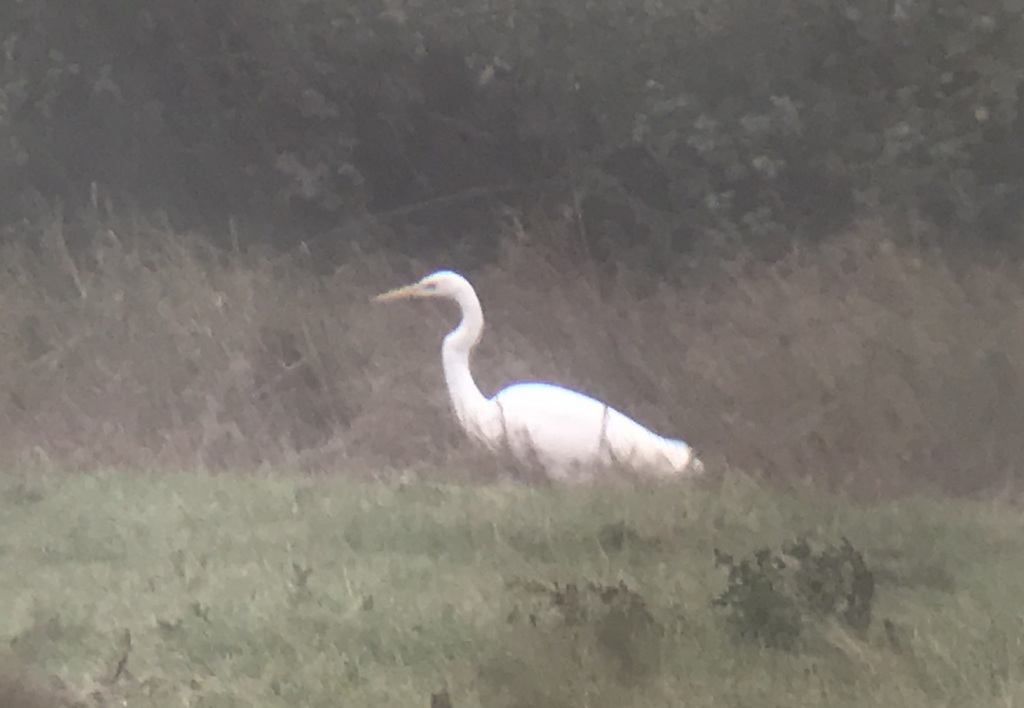
The sycamores behind Washington Hide were all quiet, although we could still hear the tits just to the east, in the pines and holm oaks. We decided to go into the hide for a sit down and a chance to dry off a little.
Looking away to the left, we could see that the second Great White Egret had now come over to the reedy channel with the first, along with a second Grey Heron. They were then joined by a third Great White Egret which flew in. Quite an impressive assemblage of herons and quite unthinkable just a few years ago, when Great White Egret was a rarity here. They have bred here this year for the second year in a row.
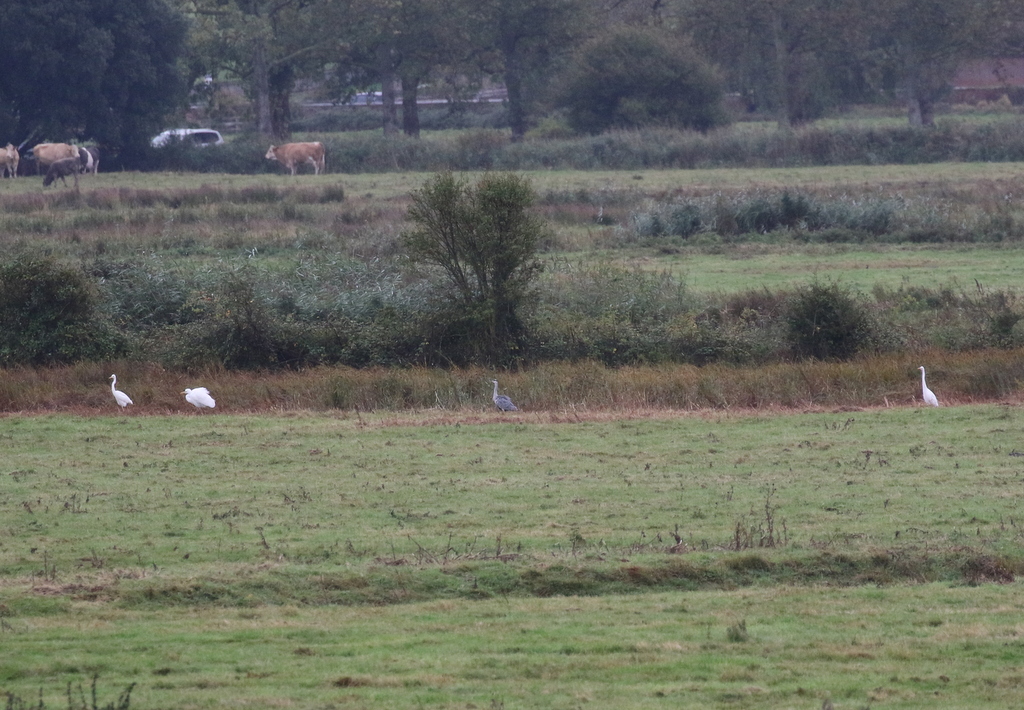
There were not many geese out on the grazing marshes today. Presumably most of the Pink-footed Geese had flown inland to feed on the stubble fields, which they do at this time of year. We did manage to find a distant collection of geese – a small group of five Pinkfeet with Greylags and a couple of Canada Geese.
There was quite a bit of activity down in the bushes in the reeds in front of the hide. There were several Song Thrushes flying in and out, presumably migrants dropping in fresh from the continent. A Ring Ouzel had been seen here earlier, and at one point it flew up into the top of a hawthorn bush. It was tricky to see, hidden in amongst the leaves, but through the scope we could make out it was a male, with a white crescent on its breast. It dropped down out of view.
As the drizzle eased off, more thrushes appeared in the bushes, coming up to preen and dry themselves out. There were several Redwings now, with bold pale superciliums and rusty patches on their flanks. A couple of Common Buzzards appeared in the tops of the bushes and then a Marsh Harrier came up out of the reeds too, as the rain stopped.
We walked back down to the gate and looked out at the bushes on the edge of the reeds. There were several Song Thrushes, grey-backed continental birds, clearly migrants coming here for the winter, but no further sign of the Ring Ouzel. While the weather was better we decided to carry on west. A closer Pink-footed Goose was on its own with a small gaggle of Greylags on the grazing marshes just beyond the trees.
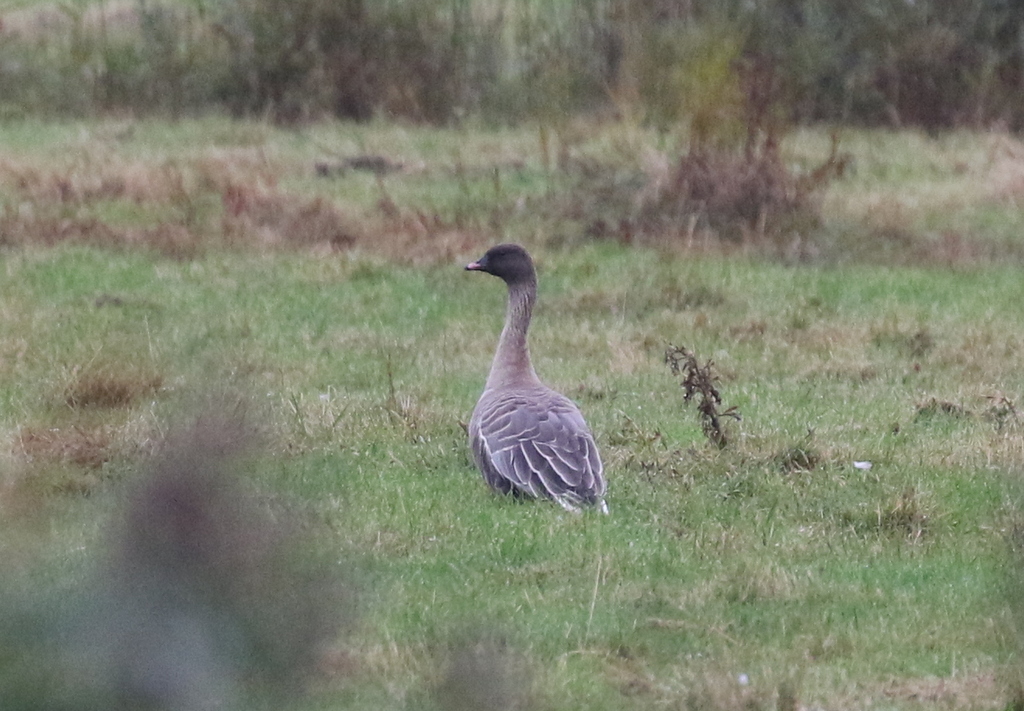
Just before the crosstracks, a Red Kite drifted out from the pines and over the bushes. It probably flushed another Ring Ouzel, as we could hear it as it flew off chacking.
There had been several Yellow-browed Warblers in the last couple of days in the sallows just beyond the crosstracks, so we walked on to see if we could find one. There were already a few people looking and we had only just walked up when we heard one calling. Triangulating the various calls there were at least two, possibly three, but they played cat and mouse with us for a while. We heard them calling and caught brief glimpses as they flew out of the bushes or perched briefly when they landed, before disappearing in.
A large oak tree provided some shelter from the wind and there was a bit of activity in the bushes in front of it. First a Chiffchaff flitted around in the ivy. Then one of the Yellow-browed Warblers flew up into a large hawthorn right in front of the oak. Now we finally had a good chance to get a proper look at one, although even here it was so active, flicking in and out of the leaves, that it was never easy to latch onto without a bit of patience. It seemed to like this tree, as it came back into it a couple of times while we watched.
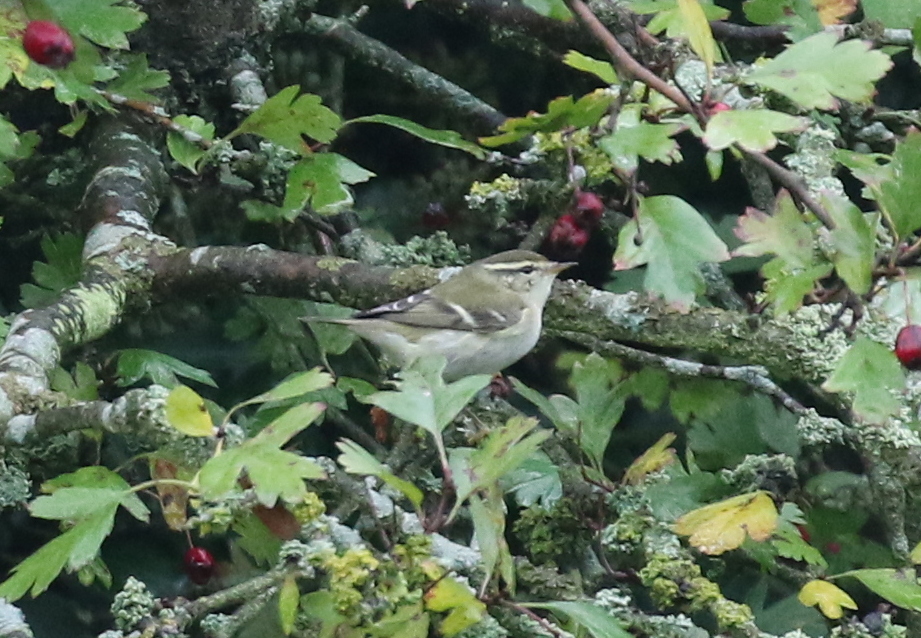
We had already heard a few Siskins over the pines on our walk out to here, but now a succession of flocks started coming overhead, calling. At first, we wondered whether it was the same flock coming round and round, but the number of birds changed each time and they were all heading quickly west. Then a message came through to say that large numbers of Siskins were on the move along the coast. We must have seen over 500 here in about 30 minutes, but even that underestimated the scale of the Siskin migration underway.
There were other birds moving too today. Two Bramblings flew in over the pines calling and circled overhead, and a few Song Thrushes were still coming in too, flying in over the trees and dropping down into the bushes.
We decided to continue on to the west end, to see if we could find anything else fresh in. As we got to the gate overlooking the grazing marshes at the end of the pines, we could see lots of white shapes feeding in with the cattle away to the south. We had a better view from higher up, just in the start of the dunes. They were a long way off, but through the scope we counted eight Cattle Egrets and three Great White Egrets, another amazing collection of birds which would have been inconceivable just a few years ago, such is the pace of colonisation of these species.
Out in the open in the dunes, the weather was not particularly pleasant – the wind had picked up, and it was still drizzling on and off. We had a quick walk round the start of the bushes, flushing a couple of Song Thrushes out, but with it getting towards lunchtime now too we didn’t have time to venture any further.
However, now we could really appreciate the true scale of the Siskin movement. Birds had been moving over the pines, which we couldn’t see on the south side of the trees. From out in the open, we could see flocks pouring through, 60-250 birds at a time, 2-3 flocks per minute. Amazing to watch! Real migration in action. There were a few Chaffinches on the move too now, and a small flock dropped into the pines around us as we walked back into the trees, a harbinger of what was to come in the afteroon.
After the walk back to Lady Anne’s Drive, we stopped for lunch in The Lookout cafe and a welcome hot drink to warm up. By the time we had finished lunch, the rain had stopped again. We drove east along the coast road to Blakeney, where a pair of Stonechats were perched on the bushes on the grazing marsh as we parked.
We thought we would have a quick walk around Friary Hills, which would be comparatively sheltered from the weather and a good place from which to observe the birds passing by overhead. There were lots of Blackbirds in the hawthorn hedge, which flushed out as we walked along and flew up into the trees the other side. Several Song Thrushes came out too, and a single Fieldfare, our first of the autumn. Four Blackcaps were feeding on the berries in here too, probably all migrants stopping off to refuel.

The Siskins appeared to have largely dried up now, but they were replaced by Chaffinches. Small flocks were passing over constantly, not on quite the scale of the Siskins earlier but on any other day they would be very impressive numbers moving. Amazing to think that these are all birds arriving here for the winter, mostly from the continent.
Down at the end of the track, a tit flock was moving quickly through the trees. A quick scan and we found a Yellow-browed Warbler in with them. It showed well, if briefly again, up in the sycamores, before the flock moved on. We tried to follow them back along the top path but they seemed to disappear back into the gardens beyond.
We stopped for a few minutes at the top, partly just to admire the view but also to see if any of the tits were still working their way in our direction through the bushes. There were several Marsh Harriers up now, quartering over the Freshes, and a couple of Grey Herons down with the cows, although there were no egrets with them here. As we walked back down the hill, a young Peregrine came in from the Freshes and disappeared inland over our heads.

To get round to the seawall, we had to walk past the duck pond with its motley collection of wildfowl. A colour-ringed Lesser Black-backed Gull was feeding on the food put out for the ducks on one of the platforms. After emailing the scheme co-ordinator, we discovered it was ringed as a youngster in Suffolk in 2010. Although it was seen all the way down in Morocco at one point (in 2014), in recent years it seems to have found Cley and Blakeney more to its liking. It was good to see the Hooded Merganser was still present in the collection here too and hadn’t escaped!

Walking out along the seawall to the harbour, a smart male Marsh Harrier quartered the grazing marshes on the other side of the bank.
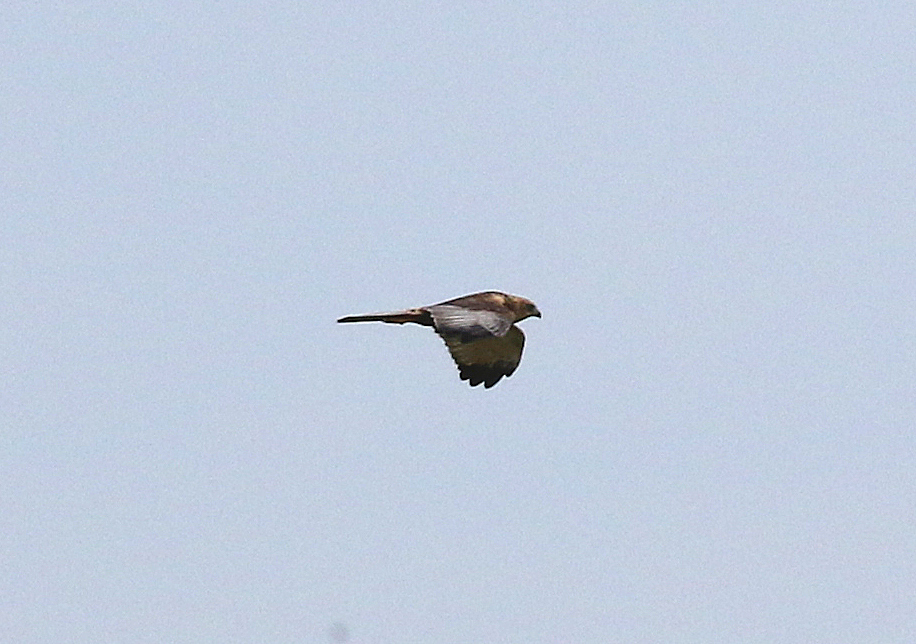
From the corner of the seawall, we stopped to scan the harbour. There were a few waders out on the mud – mostly Curlews and Redshanks. A small group of Knot, Dunlin, Grey Plover and Turnstone dropped in and started feeding busily. Further out, a couple of distant Bar-tailed Godwits were feeding in one of the deeper channels and there were plenty of Brent Geese out on the sandbars.
There seemed to be several small flocks of waders flying in. When a flock of Turnstone came in over the Glaven channel in front of us, we could see a couple of Dunlin in with them but also a much smaller wader at the back. It was clearly a stint, probably a Little Stint. Unfortunately, despite our best hopes, it didn’t land on the mud in front of us, but carried on out into the harbour and seemed to drop down out of view.
A Scandinavian Rock Pipit flew over the saltmarsh calling and dropped down into the vegetation out of view. Even out here, there were more Chaffinches still coming in or flying west in small groups, with the odd Siskin mixed in with them. It had been an amazing day for visible migration today, with all the finches moving and the thrushes in the bushes. Now it was unfortunately time to head back and wrap up an exciting four days of Autumn Migration.
















